3.3 Why business ecosystem design becomes the ultimate lever
There is nothing revolutionary about thinking in business ecosystems. In the 1990s, James Moore described business ecosystems as economic communities supported by various organizations and individuals that are in interaction—he compares ecosystems with organisms of the business world. These organisms develop their skills and strengthen their market role in the system over time; in so doing, they tend to gear themselves to one or several companies. Today, the evolutionary approach through digital ecosystems is also referred to as “black ocean strategy.” Well-known representatives of ecosystem designs are Apple and Android—both companies have successfully created ecosystems for apps.

Another example is Amazon. Alongside its original core business, Amazon has succeeded in building several ecosystems, in which the company is operating successfully. They range from Amazon Vendor Express to Alexa/Echo all the way to Web services. Amazon is a good example of the effects of digital ecosystems. Such ecosystems integrate a range of digital offers under one brand, sell primary products, grow through targeted cross-subsidies of various services, and have open interfaces or ensure interoperability. In addition, lock-in effects are often produced, driven by a high level of user friendliness and security, coupled with claims to data sovereignty and security.
For the isolated consideration of a business model, it is sufficient to think in the “blue ocean” model (Kim & Mauborgne). A creative and cross-border redefinition of market services is key to this consideration, not least in order to differentiate yourself from the competitors. The goal of a black ocean strategy, however, is to make market entry impossible for the competitors.
Existing rules are changed, new framework conditions are created, and an “unfair advantage” is built up and correspondingly used. Systems thinking (see Chapter 3.1) and the design of business models (see Chapter 3.2) are basic skills for the design of such business ecosystems.

Business ecosystem design as a paradigm for business models in distributed systems
Many projects in which blockchain is used as an enabler technology are a virtual Eldorado for business ecosystem design. The new, distributed networks cancel existing business models and make it possible to revolutionize processes, value streams, and transactions. Well-known models of business model design quickly reach their limits because they concentrate mostly on the primary business of a company and take only the direct customers and suppliers into consideration. The multidimensional view of the actors in the ecosystem with their value streams is often skipped. Thus thinking in business ecosystems in a business context becomes a factor of success.
When building a business ecosystem, a pre-investment must be made. Costs are incurred, for example, to building a platform or other innovations for development of core skills. Establishing a platform shows that we have technical skills. However, this will not create long-term relationships with the other actors. From our experience, it is by all means recommended to invest in the business ecosystem as such, and expend some thought on how each individual actor in the system will benefit from our platform and which business models come to fruition for the respective actors. There will be actors who will lose their livelihoods in this environment on account of our ideas. The profit generated in the business ecosystem should cover these investments as long as other business models don’t copy it. This brings us to the value of the overall offer in a simplified model. Ideally, the value of the overall offer rises steadily with the investments in the ecosystem.
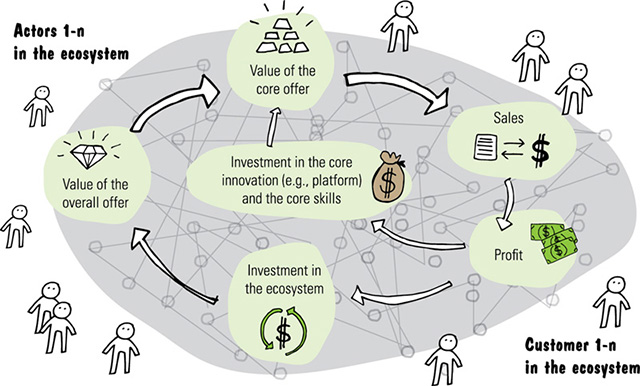
What is important with digital business ecosystems is to think increasingly in decentralized structures (see diagram). They are not centralized customer-supplier networks in the traditional sense (maturity level 1), which are geared to one company or serve a linear customer experience chain. Centralized business networks (maturity level 2) are characterized by a central player, who tries to control the whole network. Such networks exist, for example, in the automotive industry. Digital business ecosystems often have no center, and many players act on an equal footing in the network (maturity level 3).
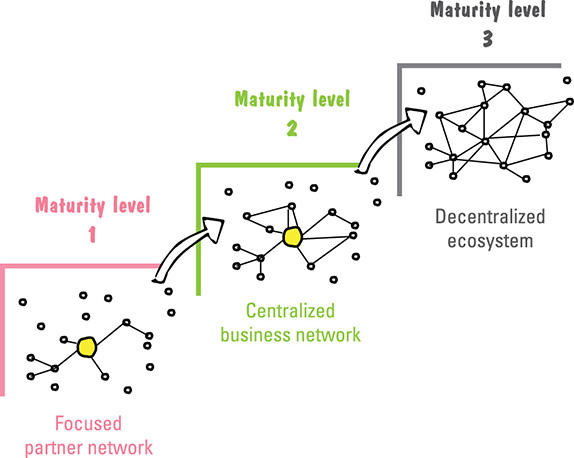
The concept of business ecosystem can be applied to all levels of maturity. In our considerations, we focus on the business ecosystem at the third maturity level, which has the following features:
- focuses on the user/customer
- loosely coupled and designed for co-creation
- networked and decentralized system elements
- coordinated and accepted value systems of the actors
- cross-industry offerings
- maximum benefit for the participants and actors
- enabled by new technologies (e.g., blockchain)
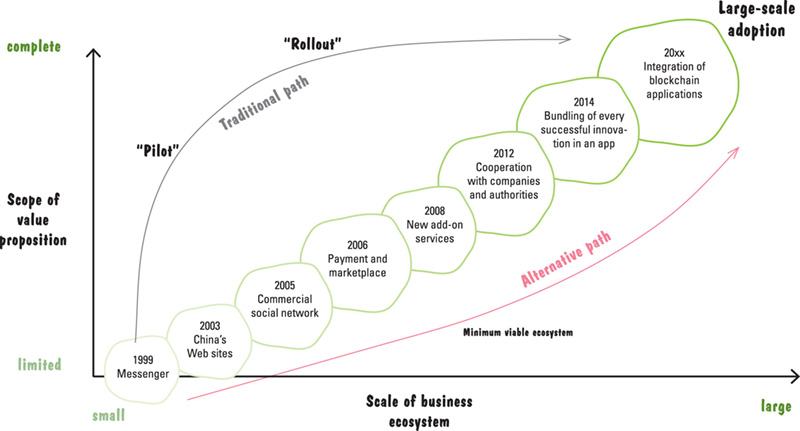
How do the ecosystem champions build systems?
The traditional path of an ecosystem structure usually consisted of iterations with a few customers to test the full value proposition. After the pilot phase came the rollout. The development costs were largely incurred before the rollout. An alternative procedure is visualized by way of the example of WeChat. The alternative path shows the evolution of a minimum viable ecosystem (MVE). With this approach, the functionalities and the value proposition are heightened if there are enough players in the ecosystem. Today, WeChat is a digital ecosystem that has systematically developed on this path over the last 10 years. The ecosystem is currently expanding in terms of acceptance of cryptocurrencies and the integration of blockchain.
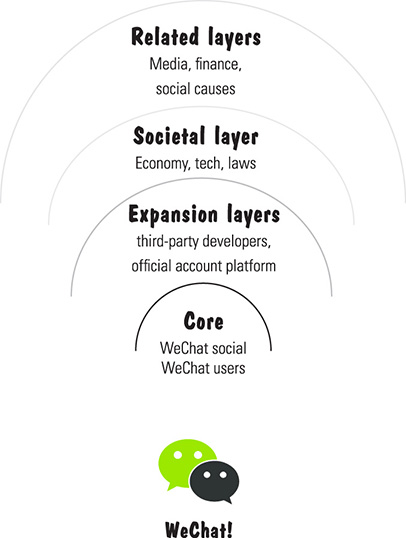
Marc and his team are facing an ecosystem design challenge for their digital business model in the health record environment, which they plan to realize based on a blockchain technology.
Marc has come up with a number of basic principles to shape his ideas for a business ecosystem. For one, he is convinced that blockchain as a technology will break through existing boundaries and industry-specific rules; secondly, he believes the dynamics in the industries will increase. Long-established industry giants in many segments will topple. This means there are market opportunities for a greenfield approach on all continents as long as a country possesses the necessary ICT infrastructure.
Marc and his team live by the principle that when you are fast and innovative, you will win in this game. When designing the business ecosystem, Marc always has his eyes on the big picture. He wants to design a system that makes it possible to establish the cycle of identification, treatment, service accounting, verification of services, medication, and reimbursement that delivers advantages to all actors and especially the patients in the system.
Through observation and research, Marc and his team have found out a great deal about the health care system and the needs of patients. The team works with customer experience chains (see figure “Current patient journey”), which help to explain the interactions, needs, and disruptions in the system. Linda was able to contribute quite a bit of important information from the point of view of an expert because she knows the day-to-day hospital operation so well. Moreover, initiatives such as Google’s Deep Mind have shown that such systems have potential. From this, Marc inferred the core value proposition, the basis for the further design of the ecosystem.

The start-up team has found various new needs from the point of view of the patients and the actors. However, the greater vision of the team is making the health care system more efficient, not least on account of the weaknesses of the exclusivity of the information in the invoices that often invites misuse. The start-up team wants to test its initial functions on the market with patients at an early stage and apply the lean start-up methodology.

Because the start-up team has the vision of improving the daily needs of the patients and actors in the system, thoughts are also focused on the service provider and the pharmaceutical industry alongside the patients. Taking these actors in due consideration, the business ecosystem is gradually redefined.

The start-up team puts the actors on the map and draws the different value streams. This way, the “virtuous design loop” for the MVE is created.
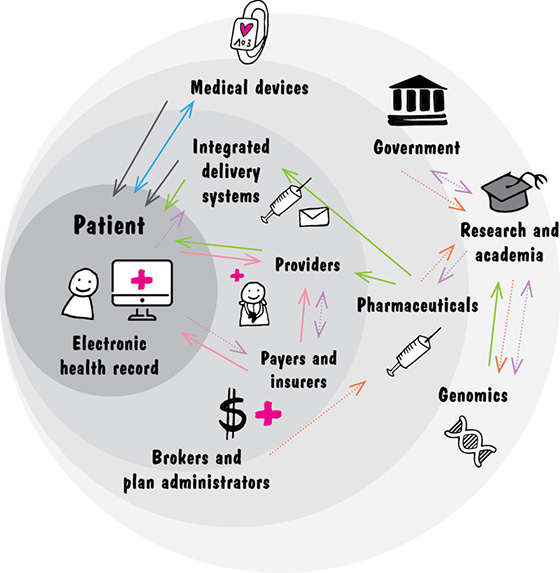
After several iterations on the business ecosystem map, the advantages for the three actors whom Marc and his team have in mind for their first MVE become visible. In the simplified model representation of the ecosystem, each actor has noticeable and strategic advantages, which come about through improved interaction with the patient. In addition, the team made a detailed analysis for each actor. The strengths, weaknesses, and opportunities and risks (SWOT analysis) as well as the resulting advantages and the motivation for each actor are therefore clear to the team.
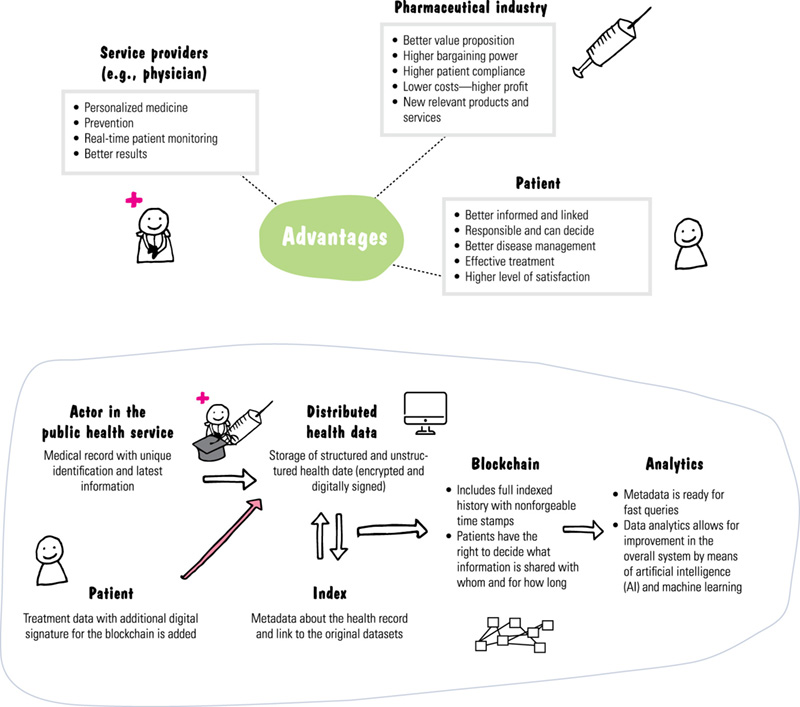
A disruptive element of Marc’s team is the implementation of the idea on a private blockchain for “health records.” It includes all the patient’s health information, and the patients decide with which actors they want to share health data. In addition, the data can be anonymized, so relevant information is filtered and knowledge about the efficiency and effectiveness of treatments is analyzed. Knowledge is created this way, and pharmaceutical studies are facilitated. The health data contains all the relevant information that is filed in decentralized systems. Access is through the access authorization of a private blockchain for which each patient has a “key.” In a next step, the overall system is enhanced by means of artificial intelligence (AI) and machine learning to improve the effectiveness and efficiency of the health care system in the medium to long term.
In preparation of a dominant role in the business ecosystem, Marc lives the design thinking mindset and proceeds iteratively. He used as the starting point the current structures in the business ecosystem, which he had observed. They had been established over the years on the basis of regulation and existing technology. By means of some design principles, such as the elimination of intermediaries or system providers, such ecosystems can be redesigned.
The central starting point in business ecosystem design is the customer/user with his needs, based on a defined problem statement. We use our well-known design thinking tools, such as customer experience chains, customer profiles, and personas. This is done before the design of the ecosystem. The design of the ecosystem usually takes place on two levels: customers/users and business, including the associated technologies and platforms. Our business ecosystem model has a total of 10 stages, which are broken down into a “virtuous design loop,” a “validation loop,” and a “realization loop.”

1) Determine the core value proposition
The core value proposition for the user/customer, or for the system, is inferred from the customer needs.
2) Determine and describe the actors in the business ecosystem
Initially considering which actors could have relevance in the ecosystem is one good way to do this. There are a number of generic market roles in systems that we can define in advance. For the analysis, we can use well-known strategic and systemic methods of analysis (e.g., PESTEL analysis). Short descriptions of the companies, in which the function and role in the system, the primary motivation, and compatibility with our core value proposition are entered, help us summarize the findings. In addition, we note the intensity of the relationship and the current business model of each actor and other aspects.
3) Arrange the actors in the different areas of the ecosystem map
Enter the actors in an ecosystem map. For the business ecosystem map, we can work with a four-part division, for example; depending on the sector and use case, other structurings are possible. We place the core value proposition in the middle. The expanded, complementary offers and the enabling networks with their actors and their customers can be placed on the outer circles. The boundaries between the individual areas are blurred.
4) Define the value streams and connect the actors with the value streams
A core element in the business ecosystem design is the shaping of current and future value streams. For simple ecosystems in traditional businesses, we would be fine with physical product/service flows, money/credit flows, and information. For digital and digitized value streams, intangible values are highly relevant. Intangible values can be knowledge, software, data, design, music, media, addresses, virtual environments, cryptocurrencies, or access and transfer of ownership and possession. These value streams are increasingly decentralized and are exchanged directly between the actors. In addition, we should also bear in mind that there are negative value streams in the system, which emerge, for example, through a transfer of risk.
5) Create awareness of the advantages and disadvantages of each actor
After the actors are positioned in the ecosystem and clarity exists about the value streams, the effects can be analyzed for the individual actors. In this phase, we focus on the advantages and disadvantages that every actor gets from collaboration in the network. Without clear advantages, we will not be able to induce enthusiasm for the system in the actors.
6) Multidimensional view of the business models of all actors in the target business ecosystem
The analyses from the previous phases help us in the multidimensional view of the business models. We consider in particular the value proposition of each individual actor for his customers and, ultimately, what the actor contributes to the core value proposition for the customer/user. We make sure that the value propositions of individual actors match. In the end, all actors should perceive the distributions of opportunity and risk in the system as fair, and they should understood the value streams resulting directly or indirectly from the system. For many companies, the interaction with a digital business ecosystem is part of the digital transformation. In Chapter 3.6, we deal with this challenge again separately.
7) (Re)design of the business ecosystem
In this phase, the business ecosystem is iteratively improved. Actors are added in the iterations or are eliminated. For example, platform providers, hardware vendors, or value-added services can be added that change and improve the existing system. The impact on the individual actors and value streams should be determined for each variant or idea of the new or adapted ecosystem. From our experience, it is important to prove the robustness of the scenarios by means of iterations and experiments.
8) Look at the decision-makers and potential team members in the business ecosystem
We designed the system in phases 1 to 7. But only reality shows whether our ideas are really viable. In the validation loop, we consider with what specific actors we initially want to validate and develop our system. The so-called interspecific relationship between participating individuals and teams ensures the existence of a business ecosystem. This involves understanding the personal interests, needs, and motivations of those involved. Especially in a symbiosis (in the wider sense), in which all individuals benefit from the interaction, positive effects are generated, which lead to the growth of the system. Alongside the rational decision to be part of the ecosystem, personal motivation (e.g., from a decision maker) is at least as relevant.
9) Form a motivated team for the design of the new business ecosystem
When designing business ecosystems, we have taken into account the needs of customers/users and of the actors. For a successful implementation, we also need the people who create the business ecosystem.
The decision makers set the framework conditions, such as range of the MVE, budget, time frame, and so on. They are the enablers of the projects. The teams are the actual doers, who contribute positive energy, intrinsic motivation, interest, and skills.
10) Build the business ecosystem step by step with an MVE
Use the design thinking mindset and the approaches of lean start-up and agile development to build the ecosystem iteratively and improve it. Create prototypes and test them systematically. The redesign of ecosystems of maturity level 3 (i.e., those that effectuate a radical change in the market and revolutionize entire industries) constitutes a challenge to traditional businesses with regard to digital transformation. The corporate culture, the lived mindset, and the ability to think in business ecosystems are therefore critical to success, alongside the elements already described.
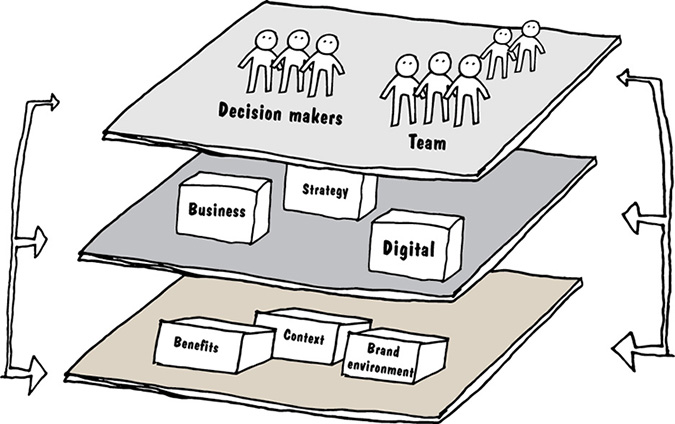
Because in many ways we work with canvas models (e.g., lean canvas or user profile canvas), we have had good experience in using the business ecosystem canvas (Lewrick & Link) for the iterative development of the system. The eight elements will help the design team across the entire design cycle (explore, design, build, test, redesign) in asking the right questions. In principle, the starting point for the design of a new ecosystem can occur anywhere. However, we recommend remaining consistently faithful to our typical starting point in the exploration phase, namely recording the customer and user needs.
In the ecosystem design canvas, all essential steps are consolidated. It is better we record the working version after each iteration (e.g., with a photo). This way, the considerations can be well documented and made traceable and comprehensible. In general, new systems (greenfield approach) or existing ecosystems can be improved with the business ecosystem canvas. When designing radically new ecosystems, certain actors in the business ecosystem can be eliminated already in the run-up. Another practical approach is first to draw up the business ecosystem predominant today and, in a second iteration, to optimize it (redesign). Especially if existing business ecosystems are to be radically restructured, the second approach makes sense, because in this line of thought, processes, procedures, information, and value streams can be redefined.


In order to apply a paradigm based on business ecosystem design successfully, you must keep five factors of success in mind:
